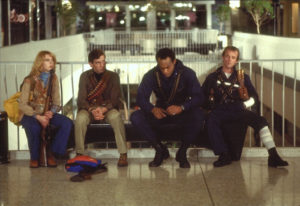Happy All-Hallow’s Month! In anticipation of Halloween — which, let’s face it, we’ve been anticipating since last Halloween — Daily Grindhouse will again be offering daily celebrations of horror movies here on our site. This October’s theme is horror sequels — the good, the bad, the really bad, and the unfairly unappreciated. We’re calling it SCREAMQUELS!
And if you like this feature, please check us out on Patreon for unique reads and deep dives! Just $3 a month gets you everything! All treats, no tricks.
How many filmmakers can claim to have invented an entire subgenre—twice? While numerous auteurs have pioneered unique styles and some have even begun trends, relatively few are responsible for starting and defining a type of film as well as a mythos that has completely entered the lexicon. In the late ’60s, director George A. Romero, along with his co-writer John Russo and the Latent Image/Hardman Associates groups, released NIGHT OF THE LIVING DEAD, a movie that brought the “siege film” structure previously seen mostly in Westerns and war films into the modern day. Even more notable is the fact that NIGHT was the first movie to feature and fully define the “ghoul” as a horror creature: while the likes of animated skeletons, revivified recently deceased people, ghosts and the “undead” vampire had haunted cinema screens before, NIGHT presented its creatures as the reanimated bodies of the dead, beings that hungered only for live human flesh, whose bite meant irreversible infection, and who couldn’t be killed except by extreme head trauma. Released in 1968, the film’s subversive political themes and bleak, unrelenting nature helped make it a massive hit, as audiences went in expecting low-budget schlock and got a trailblazing masterwork.
Thanks to NIGHT’s success and the horror genre being disreputable in the media and the film industry at the time, Romero sought to parlay his newfound status into a more varied filmmaking career, putting off the notion of making a sequel to NIGHT right away. After a decidedly non-horror effort, 1971’s BBS-style youth counter-culture relationship story THERE’S ALWAYS VANILLA, Romero angled back toward horror slightly with the Witchcraft-as-feminist-outlet drama JACK’S WIFE (AKA SEASON OF THE WITCH, 1973) and then used techniques learned during those dalliances on 1973’s THE CRAZIES, which is essentially a DEAD film that substitutes people made violently mentally unstable by a bio-weapon for flesh-eating ghouls. THE CRAZIES sees Romero marrying elements of the action-adventure film to moments of disquieting horror, suffusing social commentary throughout. It was a winning combination, but sadly the film didn’t get the release or the recognition it deserved. After exploring how the more classical elements of horror could be subverted with 1978’s MARTIN, Romero was more accepting of his place in the genre, and it was at that moment inspiration struck the director about a follow-up to NIGHT, which he would call DAWN OF THE DEAD.
DAWN began when Romero was invited by an old college friend of his, an employee of a development company, to look at the company’s newest project: a large indoor mall in Monroeville, Pennsylvania. Struck by the size as well as the isolation and encapsulation of the structure (along with an errant comment made by the friend regarding someone being able to survive while stuck inside the mall), Romero had his new setting for a continuation of the DEAD saga. When he and producer Richard P. Rubenstein couldn’t find funding for the film easily, Romero was contacted by no less than another director who had reinvented a subgenre, Italian Giallo master Dario Argento, who agreed to co-finance the sequel. While DAWN didn’t end up having anything close to a Hollywood blockbuster budget, it nonetheless had a bigger budget than NIGHT, thus giving it a larger scope than the original film.

Romero makes DAWN OF THE DEAD into a sly sequel to NIGHT OF THE LIVING DEAD, subverting expectations for people familiar with the original movie. For the film’s first act, Romero stages a series of scenes introducing the movie’s main characters—television station employees Fran (Gaylen Ross) and Stephen (David Emge), and SWAT troopers Peter (Ken Foree) and Roger (Scott Reiniger)—that chronicle the rapid breakdown of society in the face of the dead coming back to life and consuming the living. Right away, Romero frames DAWN as a semi-sequel; the rising of the dead seems to have recently occurred and the film is clearly set in the late ‘70s, making it improbable that the movie is intended to follow the late-’60s-set NIGHT in terms of direct continuity. Furthermore, the film feels nothing like NIGHT in its opening moments, instead hewing closer to THE CRAZIES in its gritty depiction of the early stages of apocalypse. Once the foursome escape in Stephen’s traffic helicopter and come upon the Monroeville Mall, they (like the shuffling dead themselves, in the film’s most pointed bit of commentary) are seduced by the microcosm of capitalism that is the mall, and decide to stay. Once they do, DAWN becomes NIGHT on a larger scale, a single-location siege film that just happens to feature a giant mall instead of a humble farmhouse. In another subversive touch when compared with NIGHT, the heroes’ safe haven isn’t breached by the hordes of dead alone—instead, they’re let in as a byproduct of an attack by a nomadic gang of bikers, the gang lured by the promise of looting material stuff in a world where much of that stuff is increasingly superfluous (best illustrated in a pair of scenes with characters stealing wads of cash from the mall’s bank—“you never know,” Peter shrugs).
The most impressive thing about DAWN OF THE DEAD in retrospect is the way it not only continues the subgenre Romero had helped pioneer with NIGHT OF THE LIVING DEAD, but becomes the new Patient Zero for the “zombie apocalypse” subgenre going forward. NIGHT is unequivocally a ghoulish horror film, its moody black & white photography aligning it with the more Gothic classical works of the genre. DAWN, by contrast, is more of an action-adventure film, its colorful palette, structure and major set pieces not evoking pervasive terror as much as blood-pumping suspense. To be sure, there are numerous moments in the film that are unsettling, disturbing, almost overwhelming in their ghastliness. Yet the arguably best remembered moments are things like the four heroes gleefully mowing down zombies while having free reign of the mall. The movie’s finale, another source of the most iconic images and gags from the film (courtesy of makeup effects designer Tom Savini, who also portrays one of the invading bikers), veers directly into comedy, intentionally so. Even the word “zombie” referring to the flesh eating ghouls, while applied in a general sense prior to DAWN, is used by Peter here (likely as a reference to the character’s Haitian heritage), solidifying the marriage between the term from Haitian folklore and Romero’s creatures.

It’s for all these reasons and more that DAWN OF THE DEAD became the gold standard for the zombie subgenre, the movie containing just about every aspect of the creature that has been explored in numerous other films, television shows, video games, comics, novels and the like ever since. Whether such subsequent works are horror, adventure, or comedy in tone, whether they are character- or action-based, whether they explore the downfall of social order, the pitfalls of capitalism, or the wish-fulfillment of a world freed from societal conventions, they have DAWN OF THE DEAD to thank. DAWN isn’t just one of the best sequels ever made, it’s unequivocally one of the most influential films ever made, a rare moniker to be bestowed on any sequel.
Tags: dario argento, David Emge, Dawn Of The Dead, Gaylen Ross, george romero, Ghoul, Hardman Associates Group, John Russo, Ken Foree, Latent Image, night of the living dead, Richard P. Rubenstein, Scott Reiniger, Screamquels, Sequels, tom savini, Undead, Zombies



No Comments